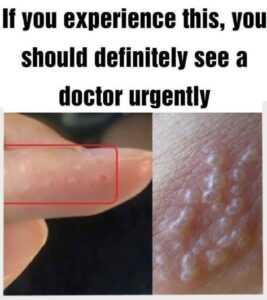If You Notice These Painful Red Bumps, It Could Be Dyshidrotic Eczema

Every spring, millions of people notice tiny, itchy red bumps appearing on their hands or feet. What seems like an allergic reaction or rash might actually be dyshidrotic eczema — a recurring skin condition that can be uncomfortable, but manageable with proper care.
What Exactly Is Eczema?
Eczema refers to a group of inflammatory skin conditions that cause irritation, redness, and itching. The most common form is atopic dermatitis, but there are many types — each with unique causes and symptoms.
In the U.S. alone, about 35 million people live with eczema, and while many children outgrow it, others continue to face flare-ups into adulthood.
Typical eczema symptoms include:
-
Red, inflamed patches of skin
-
Severe itching or burning
-
Dryness or cracking
-
Fluid-filled bumps that may crust over
Eczema isn’t contagious — but it often runs in families and can be triggered by stress, allergens, or environmental changes.
What Makes Dyshidrotic Eczema Different?
Also called pompholyx, dyshidrotic eczema causes small, deep-seated blisters that appear mostly on the sides of the fingers, palms, and soles. These blisters are usually filled with clear fluid and cause intense itching or a burning sensation.
In more severe cases, they can burst or peel, leading to cracked, painful skin. Depending on where it occurs, doctors may refer to it as:
-
Cheiropompholyx – hands
-
Podopompholyx – feet
-
Cheiropodopompholyx – both hands and feet
It most commonly affects adults between 20 and 40, particularly those with allergies, asthma, or a family history of eczema.
Common Triggers
Although the exact cause is unknown, experts believe several factors can set off dyshidrotic eczema, including:
-
Seasonal allergies, especially in spring 🌸
-
Stress or anxiety
-
Excess moisture or sweat on the hands/feet
-
Nickel or cobalt exposure (common in jewelry or tools)
-
Harsh soaps or household cleaners
-
Fungal infections
It’s important to note that it’s not caused by poor hygiene and cannot be spread from person to person.
How It’s Diagnosed and Treated
A dermatologist can usually diagnose dyshidrotic eczema by examining the skin and reviewing your symptoms. Occasionally, they might perform patch testing or a biopsy to rule out other conditions.
While there’s no permanent cure, flare-ups can be controlled with:
-
Topical corticosteroids – reduce inflammation and itching
-
Cold compresses – calm irritation and swelling
-
Moisturizers/barrier creams – keep skin hydrated
-
Antihistamines – relieve itching
-
Phototherapy (light therapy) – for chronic cases
-
Antibiotics or antifungals – if infection occurs
Avoid scratching or popping blisters, as this can worsen the condition or cause infection.
Managing It Long-Term
Consistency is key. Moisturize daily, identify and avoid triggers, and protect your hands with gloves when cleaning or washing dishes. For many people, simple lifestyle changes — combined with medical treatment — can make a world of difference.
Bottom Line
Those painful red bumps might seem small, but they could be a sign of dyshidrotic eczema — a chronic condition that flares up seasonally, especially in spring. With proper care, awareness, and medical guidance, it’s entirely possible to live comfortably and confidently, even with sensitive skin.